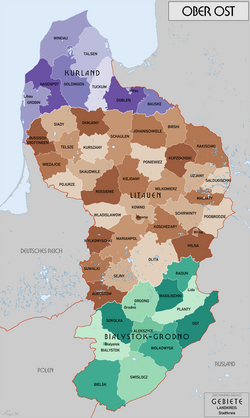
Back أوبر أوست (قائد) Arabic Обер-Ост Byelorussian Обэр-Ост BE-X-OLD Ober Ost Czech Ober Ost Danish Ober Ost German Ober Ost Spanish Ober Ost Estonian Ober Ost Basque Ober Ost Finnish
Supreme Commander of All German Forces in the East Oberbefehlshaber der gesamten Deutschen Streitkräfte im Osten (German) | |
|---|---|
| 1914–1919 | |
 | |
| Status | Military occupation authority of the German Empire |
| Capital | Königsberg (HQ, 1919)[citation needed] |
| Common languages | Polish, Lithuanian, Latvian |
| Supreme Commander | |
• 1914–1916 | Paul von Hindenburg |
• 1916–1918 | Prince Leopold of Bavaria |
| Chief of Staff | |
• 1914–1916 | Erich Ludendorff |
• 1916–1918 | Max Hoffmann |
| Historical era | World War I |
• Established | 1914 |
| 3 March 1918 | |
| 11 November 1918 | |
• Disestablished | 1919 |
| Currency | |
| Today part of | Latvia Lithuania Poland Belarus |

The Supreme Commander of All German Forces in the East (German: Oberbefehlshaber der gesamten Deutschen Streitkräfte im Osten), also known by its German abbreviation as Ober Ost, was both a high-ranking position in the armed forces of the German Empire as well as the name given to the occupied territories on the German section of the Eastern Front of World War I, with the exception of Poland.[a] It encompassed the former Russian governorates of Courland, Grodno, Vilna, Kovno and Suwałki. It was governed in succession by Paul von Hindenburg and Prince Leopold of Bavaria. It was abandoned after the end of World War I.
Cite error: There are <ref group=lower-alpha> tags or {{efn}} templates on this page, but the references will not show without a {{reflist|group=lower-alpha}} template or {{notelist}} template (see the help page).

